Natural Area Preservation News
Protecting and restoring Ann Arbor's natural areas and fostering an environmental ethic among its citizens.Volume 20, Number 4
Winter 2015
Park Focus: Buhr Children's Wet Meadows
article and photos by Catie Wytychak
While visiting Buhr Park this winter to go sledding, skating at the ice rink or touring the historic Cobblestone Farm, don’t pass up the opportunity to walk by the Buhr Park Children’s Wet Meadows. The first wet meadow was planted in 1997, and in the last 18 years the idea has spread. Two more wet meadows and about a half dozen rain gardens have been installed throughout the park. These native areas help capture, store, and infiltrate rain water from the parking lot, turf grass and surrounding neighborhood.
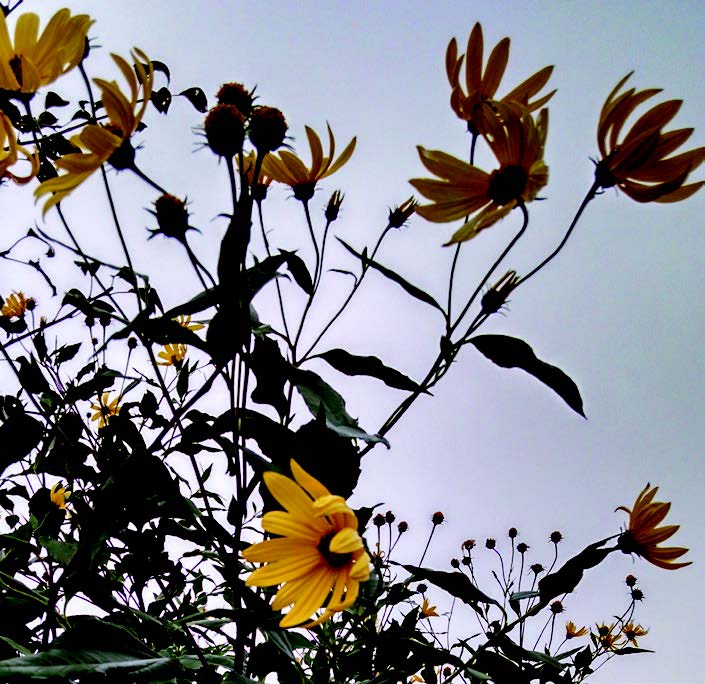 Wet meadows and rain gardens are shallow depressions where stormwater will pool briefly. Native plants with extensive root systems allow stormwater to infiltrate into the groundwater system where our soils naturally clean the water. Native plants also provide habitat and act as a food source for birds, insects, and other wildlife.
Wet meadows and rain gardens are shallow depressions where stormwater will pool briefly. Native plants with extensive root systems allow stormwater to infiltrate into the groundwater system where our soils naturally clean the water. Native plants also provide habitat and act as a food source for birds, insects, and other wildlife.
Where there are no rain gardens or wet meadows, rainfall runs off roofs and over pavement and turf, warming up and picking up pollutants, then rushing through stormdrains into the nearest creek. The sudden blasts of warm, polluted stormwater are harmful to aquatic plants and animals, carry nutrients that promote excess algae growth downstream, and cause erosion of stream banks.
The Buhr Park Children’s Wet Meadow Project (BPCWMP) was first championed by Jeannine Palms and her Blossom Home preschoolers. While volunteering with the Huron River Watershed Council, Jeannine became aware that stormwater flowing through her neighborhood’s street drains flowed directly into Malletts Creek, untreated. Jeannine’s preschool students visited the creek weekly to learn and play. As she learned more about the effects of stormwater on Malletts Creek and the Huron River, and the benefits of wetlands, she shared that with the preschoolers. One day she pointed it out when snow melt was pouring in to the storm drains in Buhr Park, and students responded with “Well, let’s make a wetland here!” Naming themselves the Super Swampers, older Blossom summer camp students (7-9 year olds), most of whom had learned about Malletts Creek as Blossom preschoolers, took up the challenge and began organizing. An adult support team was also formed.
The Super Swampers, with the aid of the adult team and other wetland professionals, created a design to build a wetland habitat in the park. Full of native plants, it would help absorb stormwater before it reached Malletts Creek, provide habitat for wildlife, and be an educational site for the community. After securing funding, coordinating with local officials, and organizing volunteers, they planted the first wet meadow in 1997. Over 1,600 seedlings and a pound of seeds were planted with the help of 100 volunteers over two weekends.
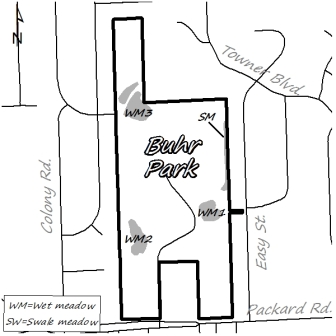 With funds left over from the first wet meadow project, the BPCWMP paid for a design for all of Buhr Park, with the goal of zero runoff from the park. Implementation of the design has continued with the installation of two more wet meadows and an extension of the first one. Two of the Super Swampers, Celia Haven and Yousef Rabhi, now adults, each took on the management for one of those wet meadow installations.
With funds left over from the first wet meadow project, the BPCWMP paid for a design for all of Buhr Park, with the goal of zero runoff from the park. Implementation of the design has continued with the installation of two more wet meadows and an extension of the first one. Two of the Super Swampers, Celia Haven and Yousef Rabhi, now adults, each took on the management for one of those wet meadow installations.
Natural Area Preservation conducts controlled burns of the wet meadows to promote the growth of the native plants and keep the landscape open. These events have become a great opportunity for the publi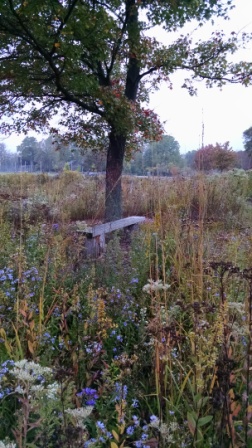 c to learn about controlled burns and participate by spreading seeds after the burn. The burns at the Children’s Wet Meadows are great teaching opportunities, a valuable chance for NAP to explain why we have controlled burns in many of our parks. Some neighboring families have attended the prescribed burns annually and enjoy the sight of wildflowers popping up a few weeks after the burn.
c to learn about controlled burns and participate by spreading seeds after the burn. The burns at the Children’s Wet Meadows are great teaching opportunities, a valuable chance for NAP to explain why we have controlled burns in many of our parks. Some neighboring families have attended the prescribed burns annually and enjoy the sight of wildflowers popping up a few weeks after the burn.
The Buhr Park Children’s Wet Meadows Project is an example of how a community can come together to develop creative solutions. NAP staff are happy and grateful to have been able to facilitate the process, and look forward to continuing our participation in the Project. If you want to be involved in any of these community efforts, there are plenty of opportunities! To learn more, visit
www.WetMeadow.org.
by Dave Borneman, Deputy Manager for Volunteerism and Natural Area Preservation
“'Rest!' cries the Chief Sawyer…"
If you’re not immediately familiar with this phrase, then you’ve never read the great classic A Sand County Almanac written by Aldo Leopold, often considered the father of the modern conservation movement. Much of the book is his reflections written each month of the year. His February chapter is entitled, “The Good Oak” and tells the story of sawing through an old oak tree that was killed by lightning, laying up firewood for the next winter. This endeavor provides ample opportunity to reflect on important events that transpired during the decades of the tree’s life. Repeatedly throughout the story, this line is repeated: “’Rest!’ cries the chief sawyer, and we pause for breath.”'
It’s good advice, whether you’re cutting firewood, or just finishing up another busy year of park stewardship. We can all look back on 2015 with great satisfaction. We’ve accomplished a tremendous amount, as summarized nicely by the stats on the back page of this newsletter. Much of our work the past 12 months has been about trying to maximize efficiency or results: pulling the most garlic mustard, getting the most acres burned, cutting the most buckthorn, counting the most species of birds, etc. … Those are some of the main goals of NAP staff and volunteers at workdays and other activities.
And that’s all good. But sometimes in the hustle and bustle of these busy fieldwork months, it’s easy to lose touch – at least temporarily – with what is really most important. That may be different for each of us, but for many, it would include some kind of relationship in which we find ourselves. Maybe it’s our relationship with a partner, or with our family, or with nature, or with some other divine presence. Maybe it’s our relationship with our self, and taking good care of our self. Whatever you put in that top slot - your highest priority – deserves some serious good-quality, focused, attention from you. And what better time for that than now, as the field season is replaced with the holiday season at the end of the year. It’s an obvious time to rest, and pause for breath.
Take advantage of this time to look back on what you’ve accomplished this year, and to celebrate your successes. Take time to reflect on your failures and make sure you have fully learned from those experiences. Take time to rebuild and strengthen those relationships that are most important to you, because these are the relationships that will sustain you through the hectic times ahead, when you may find it harder to make time to nurture them. Take time to get out and enjoy the parks this winter, as the next article suggests. And if you’ve never read “A Sand County Almanac,” or if it’s been awhile, take time to read that, or another good nature book that you’ve been wanting to read. Take care of yourself and your relationships this winter. Rejuvenate yourself and them. We’ll look forward to seeing you next year, refreshed and reinvigorated and ready for another great year!
Parks in Winter
by Rafa Contreras-Wrangel
When we think of nature areas, images of vast green forests and prairies full of flowers often come to mind. In the depth of winter, we often yearn for spring to arrive so we can go back and hike our favorite parks. During this time, many of us like to stay indoors with a good book in hand and a warm cup of coffee while we wait for spring, leaving our parks and natural areas we love so much throughout the year nearly forgotten.
We forget our parks and natural areas because winter makes days cold, wet, and gloomy, but not all days are like that. Sometimes winter gives us a day that is not windy, snowy, or overcast. Sometimes it gives us a windless day with a clear blue sky, making us wonder if spring has come early. If you have never visited your favorite park over the winter, then I suggest that you put on your best snow boots and visit it on one of these bright sunny days. The world is a different place during winter. The foliage is gone, allowing for different and distant views of the Huron River, small creeks, distant big trees, the cityscape, and other features of the landscape that are obscured by leaves or just easy to miss in other seasons.
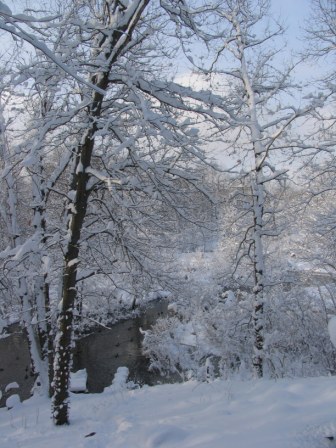
The Beauty of Winter, by Dea Knopf, 2008 NAP Photo Contest
If you are not sure
where to start your winter visit, or if you think the park you want to visit might be too much to handle at the moment, a great place to start is the Border-to-Border trail (B2B) along the Huron River. The B2B trail runs along the open spaces of the Huron River Greenway, and in the city it connects many of the parks along the Huron River, including Bandemer, Argo, Fuller, and Gallup, among others.
If this is your first time visiting a park during winter, Gallup would be a great place to start. On a sunny day, you will be able to see the spectacular view of the sun’s reflection off the ice-coated Huron River. You can also make your way west on the paved B2B trail to view the snow-covered wet prairie against the background of the Huron River, now visible thanks to the recent restoration efforts. At the end of your walk, if you’re feeling adventurous, you can always jump over to Ruthven Park across Geddes Road. Ruthven contains a special kind of hill called a glacial kame. The sand and gravel that makes up the hill were first deposited in a depression in glacial ice, and then left behind when the ice containing it melted away. Now the fast-draining soil of the kame is home to many wildflowers and other native plants adapted to drought dry condition. From the top of the kame you can look across the river valley, and with the leaves off the trees see the bluffs cut by the river below. Add the snow-cover of winter to the landscape and you are able to step back in time a few thousand years and see the shadow of an ancient ecosystem.
The world can be a harsh place during winter. Plants go dormant, many animals sleep or migrate, and humans seek refuge. But winter is also magical in a way. It marks the end of a year, the end of a cycle. It completely changes landscapes compared to the other seasons, and it rewards those who are willing to explore it. So while the cold of winter might discourage you from venturing to the outdoors, remember that the most precious treasures are often hidden in the harshest of places. You might find that your favorite park is ten times better during winter. All you have to do is brave the cold for a day.
NAPpenings
Welcome, New Park Stewards!
Tim and Robin Damschroder
- Ruthven Nature Area
Michelle Camilleri
- Miller Nature Area
Shawn Severance -The Ponds
Jeff Vornhagen and Stacie Printon -
transferred to Oakwoods Nature Area from Stapp and Leslie Woods
Thank you!
Many thanks to the groups who volunteered with NAP recently. We could not make such a difference without you!
- Concordia University Ann Arbor’s first year students
- Deloitte Consulting
- EMU Biology 226
- EMU Vision
- Greenhills School
- UM Indian American Student Association
- UM Michigan Community Scholars Program
- UM Delta Sigma Phi
- UM Environmental Ecology
- UM Epsilon Eta
- UM Law School
- UM Medical School
- YMCA Ann Arbor Youth Volunteer Corps
Thank you to the local businesses and organizations that donated prizes for our Volunteer Appreciation Potluck!
Thanks to new Eagle Scouts!
-
Nate Helberg and his team built and installed trail markers at Dolph Nature Area.
-
Will Norton and his team built viewing benches and a picnic table at South Pond Nature Area.
Staff Update
Welcome…
 George Hammond
George Hammond
After years as a volunteer, I’m now a staff member at NAP! At last, all the secrets of the parks are mine! Bwah ha ha... ahem. :-)
Ok, actually not so many secrets, but a place on a hard-working team of friendly folks, and a chance to work in our parks. Very exciting! Previously I worked at the UM Museum of Zoology, for the Animal Diversity Web educational website. The ADW is still online (and worth a look), and I still work with them too, but we’re not in the Museum anymore, and I’m wearing both NAP and ADW hats. I’m happy to be able to put my ecological and editorial training to work for NAP.
 Logan Nevins
Logan Nevins
I am excited to be at NAP as the Workday Coordinator to work with the great network of volunteers that Ann Arbor has. This volunteer network takes great pride in managing their parks and I am glad I get to be a part of it. I am excited to bring the skills I learned from earning a Conservation Biology degree from Lake Superior State University to NAP and work at continuing the conservation efforts NAP has been known for. Workday Coordinator allows me to enjoy my passion for the outdoors while helping others get involved in managing our great nature areas.
 Dan Engel
Dan Engel
I recently graduated with a Master’s degree from the University of Michigan studying Conservation Ecology and Environmental Informatics. Ever since taking an ecology course in undergrad, my career goal has been to restore degraded ecosystems to benefit both people and wildlife. I am excited to make that a reality here in Ann Arbor by serving with NAP and the amazing volunteer crews!
 Morgan Boyer
Morgan Boyer
I graduated from the University of Michigan – Flint, earning a degree in Wildlife Biology with a minor in Environmental Studies. My previous work with the DNR and the Genesee County Parks has focused on public education and conservation. I am excited to join the NAP field crew to see the restoration practices I have taught other people about put into use within the city park system. I look forward to working with the wonderful people of Ann Arbor in helping promote natural areas for everyone to enjoy!
Update…
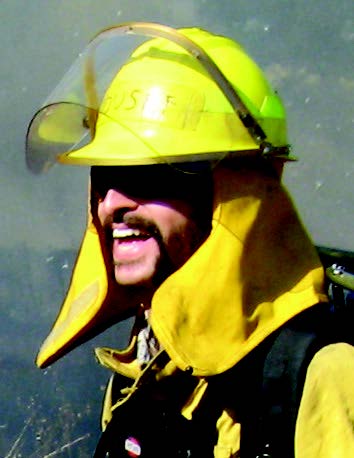 Yousef Rabhi, former NAP staffer and Children’s Wet Meadows kid, sent us a message when he heard we were writing about the Buhr Park meadows: “In preschool we were very interested in how our actions impact the environment around us. From an early age I remember studying the critters in the segment of Malletts Creek that runs through Scheffler Park and planting plugs for what would soon become the Buhr Park Children’s Wet Meadow Project! Many of my policy approaches and deep love of nature can be linked to these early experiences. It certainly was central to my run for County Commissioner back in 2010 and remains foundational as I run for State Representative!”
Yousef Rabhi, former NAP staffer and Children’s Wet Meadows kid, sent us a message when he heard we were writing about the Buhr Park meadows: “In preschool we were very interested in how our actions impact the environment around us. From an early age I remember studying the critters in the segment of Malletts Creek that runs through Scheffler Park and planting plugs for what would soon become the Buhr Park Children’s Wet Meadow Project! Many of my policy approaches and deep love of nature can be linked to these early experiences. It certainly was central to my run for County Commissioner back in 2010 and remains foundational as I run for State Representative!”
Farewell…
 Liz Banda
Liz Banda
I thoroughly enjoyed my time with NAP, although I was only with the crew a short time, I learned a great deal about native flora as well as increased my knowledge of invasive plants and how to manage them. I will very much miss interacting with all of the great volunteers as well as my former co-workers. I will now be working with Davey Resource Group and will be using many of the skills I learned at NAP in my new position as a Consulting Utility Forester.
NAP By the Numbers: Volunteer Highlights of 2015
This year, volunteers spent over 8000 hours working in 50 parks around the city!
NAP crew spent 1500 hours working on 337 acres in 38 parks!
We had over 3000 volunteers at workdays (public and private) this year alone.
Bird Survey volunteers observed 135 species and volunteered 150 hours. Since 1990 235 species of birds have been seen in city parks!
Frog & Toad and Salamander Survey volunteers gave almost 375 hours this year, and logged 325 observations of amphibians and reptiles in our parks.
Photo monitors spent 36.5 hours taking photos in the parks.
You can help our numbers grow! Volunteers help us keep track of the plants and animals in our nature areas. Check the
calendar for the survey training and kickoff events coming in early spring. We would also be delighted to have you come to our public workdays, or contact us about organizing a private workday for your group!
